Audi Q4 e-tron Sportback
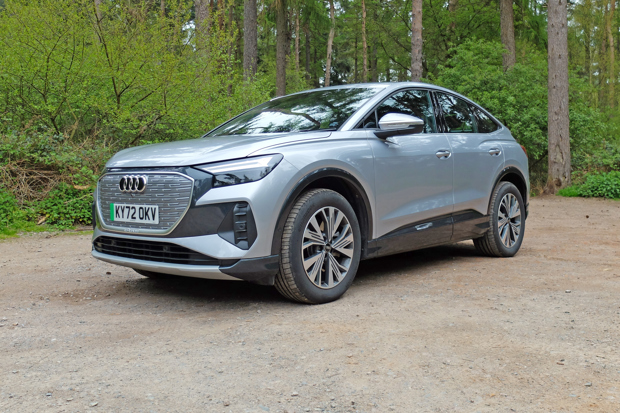
Specifications: Audi Q4 e-tron Sportback Sport 40
- Run by: Sarah Tooze (since January 2023) and David Ross (from March 2023)
- Price when new: £56,445 (£61,460 including options)
- Battery: 82 kWh
- Power: 204PS
- Torque: 310Nm
- Claimed consumption: 3.7 mi/kWh
- Range: 326 miles
- Insurance group: 31
- Report 1: We welcome Audi's popular electric SUV
- Report 2: Can you run the Audi Q4 e-tron when you don’t have a home charger?
- Report 3: Should you charge the Audi Q4 e-tron to 100%?
- Report 4: How much does it cost to run an electric car?
- Report 5: What's exactly is a Sportback?
- Report 6: We say goodbye to the Audi Q4 e-tron Sportback
Report 1: We welcome Audi's popular electric SUV
Audi's most popular electric car is the Q4 e-tron and we will be running one for the next few months.
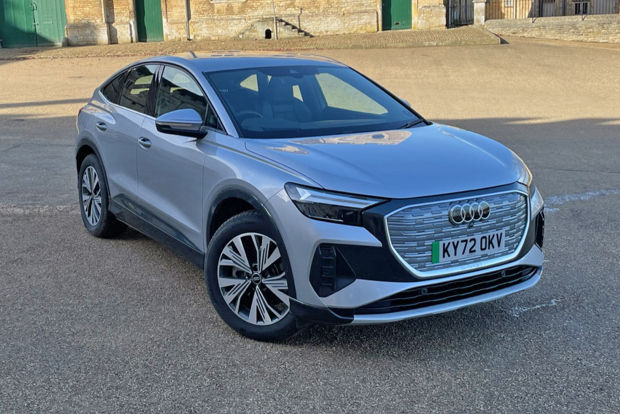
Date: 24 January 2023 | Current mileage: 2140 miles | Claimed consumption: 3.7 mi/kWh | Actual consumption: 3.2 mi/kWh
In my first two weeks of running the Audi Q4 Sportback 40 e-tron its looks have been getting plenty of attention. For some, the sloping roofline (which gives it the Sportback name), fancy alloys and sweeping headlights give it a “futuristic look”. One stranger commented: “It looks like a spaceship.” Others have made lots of cooing noises and commented on the “plush” interior.
A friend who drives a Volkswagen Golf ID.3, which is built on the same Volkswagen Group platform as the Q4 e-tron, was more interested in what the Q4 e-tron is like as an electric vehicle. “What’s the battery size?” they wanted to know.
Well, Audi has discontinued the Q4 35 e-tron, which had a total capacity of 55kWh so the range starts with the Audi Q4 40 e-tron, which has a useable battery of 76.6 kWh. That’s bigger than the 58 kWh battery you’ll find in the VW ID.3’s Pro Performance model (understandable given the price difference between the two models) but also bigger (just) than key rival the BMW iX3’s useable battery capacity of 74kWh.
For me, battery capacity is all-important too as I don’t have the ability to charge at home, although my friend with the ID.3 has a wallbox and has let me top up several times at theirs.
They are on a cheap overnight tariff with their electricity provider (15p per kWh) while charging the Q4 40 e-tron during the day at theirs costs 39p per kWh. That means it would cost £29.87 if I’d needed to fully charge (still cheaper than a tank of diesel) and the cost for some EV drivers with historic agreements with their energy providers will be even less.
The Q4 40 e-tron Sportback’s official range is 326 miles, although as I’ve taken delivery of it in winter the current range is more in the region of 240 miles. That still means my top ups aren’t frequent as I’m a low mileage driver and rarely have to do long journeys.
Audi has supplied three charging cables for rapid charging, slow charging with a three-pin plug and a type 2 cable. It says that 93 miles can be added in just 10 minutes using a 22kWh charger.
The cables are stored beneath the boot’s false floor which is much more practical than other EVs I’ve driven in the past where boot space is taken up with multiple cables. Surprisingly the official boot capacity for the Sportback is actually 15 litres more than than the standard Q4 e-tron (535 litres versus 520).
I’ll be finding out over the next few months how much it costs to charge using the public charging network and how convenient (or not) that is. I’ve already scoured Zap Map and there are four locations in the town I live where I can charge. That’s better than the one charging location in another nearby town (and that location is at a school with restrictions on public use).
Report 2: Can you run the Audi Q4 e-tron when you don’t have a home charger?
We find out if it’s feasible to run the fully electric Audi Q4 e-tron without the ability to charge at home.

Date: 7 February 2023 | Current mileage: 2477 miles | Claimed consumption: 3.7 mi/kWh | Actual consumption: 3.2 mi/kWh
In the last few weeks I’ve been finding out if it’s feasible to run the fully electric Audi Q4 e-tron when I don’t have the ability to charge at home.
I can’t even use a standard three-pin socket to charge as there isn’t one within reach of my parking space, and I won’t be foolishly hanging a domestic extension lead out of a ground floor window to charge it as there’s a risk of it overheating and, understandably, isn’t recommended by car manufacturers.
Initially, when I took delivery of the Audi Q4 e-tron I relied on the goodwill of a friend with an EV for a couple of top-ups using their wallbox but I’ve now switched to public charging - or “charging in the wild”, as it’s sometimes dubbed.
The cheapest public charging point nearest my home is in a council-owned pay and display car park. When the 11kW charging points were first installed the council let EV drivers charge for free but like a number of other charging locations, that’s no longer the case and it now costs 36p/kWh.
Zap Map suggests that EV drivers have the perk of not paying to park in this particular car park instead but mixed reviews about that from other drivers made me decide not to risk parking without a ticket.
The chargers are operated by Swarco E.Connect and to charge I haven’t even needed to install an app. I simply plug the car in, visit the website and enter the charge point details and pay with a credit card. By contrast, if I’d wanted to charge in a local supermarket car park I would have needed an app and to pay a connection charge, although parking itself would definitely have been free of charge.
I always check on Zap Map that there’s a charger available before I go to the car park and although there is usually one or two other cars charging, I’ve never had a problem.
I wouldn’t want to charge there late at night on my own, however, which supports the findings of HonestJohn.co.uk’s research and online used car marketplace heycar’s campaign calling for public EV charging locations to have safety features such as CCTV and good lighting as standard.
I’ve found that the Q4 e-tron warns you to recharge when you have less than 30 miles range remaining with the battery gauge turning an angry red, which has meant I haven’t dared run it below 12%.
In that instance I was able to charge it from 28 miles to 49 miles in 36 minutes, costing just £2.51, and boosting the battery to 20%. So in my town at least it is possible to rely on public EV charging, especially when you have a car with a decent range, like the Q4 e-tron, and you’re not a high-mileage driver.
Report 3: Should you charge the Audi Q4 e-tron to 100%?
While you'd think charging your electric car to the max to give you the best range would be best, that's not actually the case.

Date: 27 February 2023 | Current mileage: 2605 | Claimed consumption: 3.7 mi/kWh | Actual consumption: 3.1 mi/kWh
So after a few months, I've now taken on running the Audi Q4 e-tron from Sarah. I've had a few plug-in hybrids before like the Volvo V60 PHEV, but this will be my first experience of running a purely electric car for any length of time. I've so far resisted the switch to an EV so this should be an interesting few months.
I've driven plenty of electric cars before, but usually only for a week at the most. So I'm looking forward to living with an EV and seeing how it copes with everyday life.
First impressions after taking it on from Sarah's very capable hands are on the whole positive. It has the usual Audi quality inside and a surprising amount of rear legroom which our three children are already very happy about. It also means I can drive with my seat in a comfortable position...
The main issue for us, however, is charging. We don't have a wallbox as yet so we're relying on a standard three-pin socket in our garage along, which as I know from experience, takes an age to fully charge an electric car.
One thing I've already noticed while going through the various MMI screens is the charging display that recommends you only charge to 80% in normal use, saving 100% for long journeys.
A quick call to the experts at Audi shed some lights on why. Regularly charging to 100% puts more stress on the battery and can accelerate the ageing process. This causes the available battery capacity to decrease at a comparatively faster rate.
This is why Audi recommends charging up to a maximum of 80% if your car is mainly used for short trips. When going on longer trips, on the other hand, the maximum battery capacity should be fully utilised to extend the car’s range – but only shortly before the start of the journey to prevent a gradual loss of power.
Audi also recommends fast charging (high power charging with over 100 kW) primarily when traveling long distances.
If the car frequently goes unused over the course of the day, they say to keep the charge level between 30% and 80% – not too full to accelerate the ageing process, but not too low to have too little range.
Report 4: How much does it cost to run an electric car?
One of the big attractions of electric cars is that they are cheaper to run than petrol or diesel equivalents. But how much does it actually cost to run an electric car like the Q4?
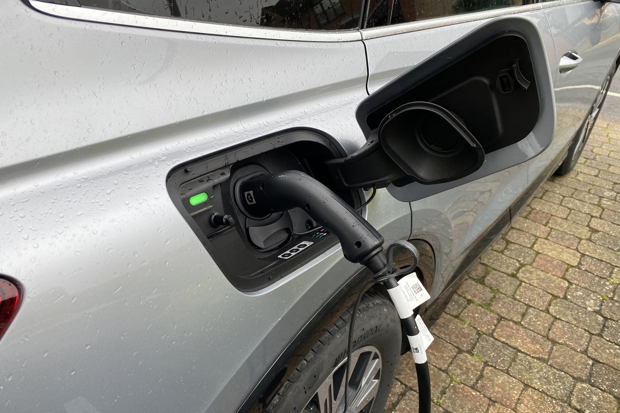
Date: 13 March 2023 | Current mileage: 2911 | Claimed consumption: 3.7 mi/kWh | Actual consumption: 3.0 mi/kWh
So far, I'm finding life with an electric car very straightforward. Although that's probably because we haven't had any long journeys to content with.
Like most people, me and my partner mainly work from home now and only venture into the office once a week. And for me that involves a short drive to the local station car park to get the train to London.
The Audi Q4 e-tron is proving easy to live with and while it's not exactly what I'd call exciting, it is very capable nonetheless. But the key attraction for us, is that this should be cheap to run. With our family car a diesel Audi Q7 that only averages around 30mpg, having something else that doesn't cost the earth will be a real bonus.
So the question is, how much does it cost to run the Audi Q4 e-tron? Well so far we've managed to avoid public charging, instead sticking with our trusty three-pin wall socket. Our tariff with SSE sees us pay 35.05p per kWh with a standing charge of 38.94p a day.
We're currently averaging 3.0 miles per kWh from our Q4 e-tron, which means it costs 11.7p per mile to run. This doesn't include our standing charge though, which for a 31 day month is £12.07.
To charge it completely from zero would cost around £26.80 and gives us a range of around 230 miles. The Q4 e-tron 40 has an 82kWh battery but only 76.6kWh is usable.
Compare that to a similar size petrol car averaging 40mpg (or 8.8 miles per litre) and with standard unleaded at 139.9p a litre near us, this works out at 15.9p a mile.
Over a 250 mile journey that's a saving of about £10, which isn't exactly groundbreaking. The fact energy prices have rocketed hasn't helped of course, but given how expensive electric cars are in comparison to their petrol equivalents, you'd be forgiven for expecting a bigger saving.
Report 5: What's exactly is a Sportback?
We chose the Audi Q4 e-tron Sportback over the standard Q4 SUV. But what exactly does Sportback mean and is it worth choosing?
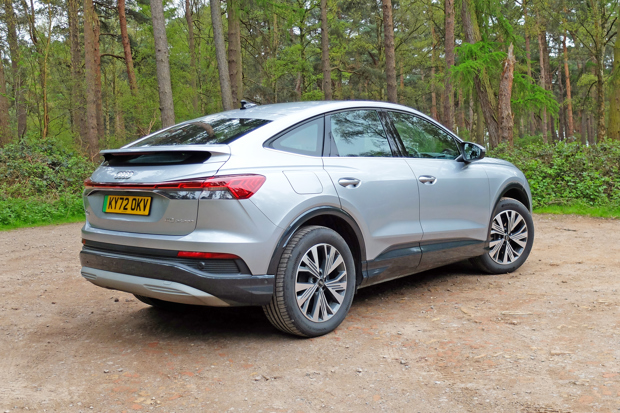
Date: 3 April 2023 | Current mileage: 3389 | Claimed consumption: 3.7 mi/kWh | Actual consumption: 3.0 mi/kWh
Understanding the Audi model range can be a whole world of confusion at the best of times. If there's a niche, chances are, Audi has a car to fit in it. From the Audi A1 CityCarver to the Audi RS Q8, there is no shortage of choice. Which for buyers can be a little overwhelming.
And to add to that, in among all these models, Audi further diversifies by having Sportback models. I'm old enough to remember going on the launch of the first Audi Sportback model - the A3 Sportback - in 2004.
This was essentially the five door version of the 2003-generation Audi A3, but it also had a different rear end design, giving it a new look and more space.
Since then, the Sportback name has been used on plenty more models, like the popular four-door Audi A5 Sportback. While now there's a range of Sportback versions of SUV models, including the Q5 Sportback and the Q4 e-tron Sportback.
However, unlike the original A3 Sportback, these are now less practical than the standard models they are based on. So while the Audi Q4 e-tron is a traditoinal SUV design, the Q4 e-tron Sportback, which we're runningm has a rakish, coupe-like design.
The result is a more sleek look but at the expense of practicality, a strange change for the Sportback name which was once associated with more doors and more room. The Q4 e-tron Sportback also costs £1500 more than the standard model.
So is it worth it? Well interestingly, despite the swoopy rear end design, the boot space is actually 15 litres bigger in the Q4 Sportback than the Q4 on paper. That said, you we still found it easier to fit in boxy or awkward objects (like bikes) in the back of the Q4. You also don't get roof bars on the Q4 e-tron Sportback, unlike the Q4.
But for our everyday use with a pushchair, shopping and the odd children's scooter, the Q4 Sportback copes fine. One negative about the Sportback however is that the design doesn't do many favours for rear visibility, which is pretty poor due to the Honda Civic-style split rear window and spoiler.
While I think it looks attractive, it is hard to justify paying a premium for a Sportback over a standard Q4, which we think is already a neatly styled SUV.
Report 6: We say goodbye to the Audi Q4 e-tron Sportback
After three short months, it's time to say goodbye to our Audi Qe e-tron Sportback. So what's the final verdict on the all-electric SUV?
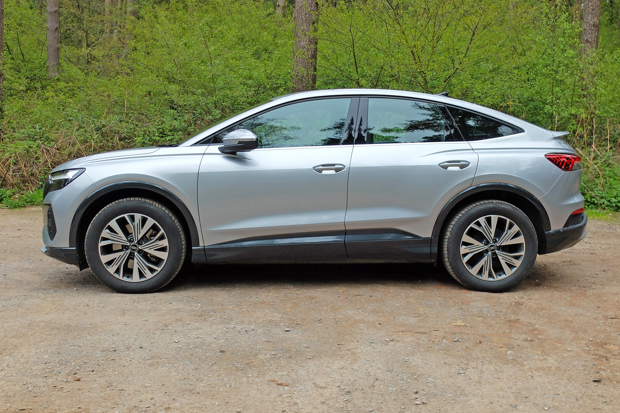
Date: 28 April 2023 | Current mileage: 3811 | Claimed consumption: 3.7 mi/kWh | Actual consumption: 2.9 mi/kWh
Well those three months flew by. It only seems a few weeks ago our shiny Audi Q4 e-tron arrived and now it's time for it to return to Audi HQ. It started life with Sarah, our consumer editor, before she handed the keys over to me.
We both have children to transport around and neither of us have a dedicated wallbox to charge an electric car, so we've been able to share our experiences. But what we both agree on, is that we found the Audi Q4 e-tron easy to live with day to day.
A proper charing point would have made life easier for both of us, but Sarah at least got to know her local EV charging points and ZapMap better while I charged it from a standard three-pin domestic socket.
It takes a long time to charge from empty, more than 35 hours according to the in-car display, but we rarely used all the 230 mile range, so it was just a case of keeping it topped up - and remembering to plug it in when we came back. Something I did occassionally forget in between attempting to get the kids, shopping and everything else into the house after a day out.
We have experienced one charging issue at a BP charging point in Milton Keynes. The Q4 e-tron flashed up with an error and wouldn't charge. The same thing occurred when I moved to a different charger in the same car park. Luckily I had enough charge to get me home and the fault never reappeared.
Like most modern electric cars, the Audi Q4 e-tron is quiet and effortless to drive, but it also suffers from the usual overly firm ride of EVs. The weight of the batteries means the suspension has to be adjusted accordingly which means few electric cars ride especially well. The Q4 is certainly on the firm side.
It may not have much in the way of character - few electric cars do - but it does handle well and thanks to all that low down torque, it's actually quite fun on quiet country road.
One disappointment was that the Audi Q4 e-tron didn't prove as cheap to run as we expected, a combination of high energy costs and decreasing fuel prices have eroded the savings made when compared to a petrol equivalent.
But for our use - local driving with school runs and the odd longer trip for days out with the kids - the Audi Q4 e-tron has proved ideal. The 230 mile range has been more than enough and we've had zero concerns about range.
So what's next? Well we're sticking with an SUV but switching to a hybrid with a Honda CR-V replacing the Audi Q4 e-tron. However, this won't be the last e-tron we run as a long termer, with something planned for later in the year.
